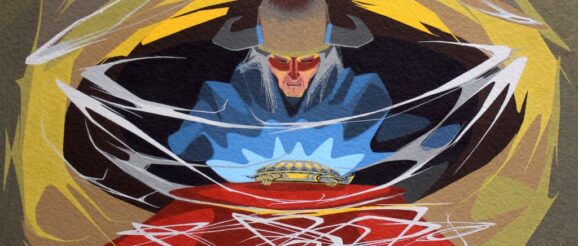Pattern and Innovation: Oscar Howe at the Portland Art Museum

Born on the Crow Creek Reservation in South Dakota, Oscar Howe (1915–1983) absorbed through his grandmother’s stories a deep knowledge of his people and their religion. This heritage formed the lifelong basis of his art. In paintings and drawings, he explored the traditional daily activities, sacred ceremonies, and solitary vision quests of his Dakota community. An artist from a young age, Howe studied in the 1930s at the Santa Fe Indian School, trained as a muralist while working for the WPA, and eventually joined the faculty at the University of South Dakota, Vermillion, in 1957. Though less well-known today than his younger contemporaries Fritz Scholder (Luiseño) and T.C. Cannon (Caddo/Kiowa), Howe did not lack for recognition in his lifetime. He received numerous public commissions and multiple honorary degrees, and, in 1960, was named Artist Laureate of South Dakota.
Howe’s development is clear in this retrospective at the Portland Art Museum, curated by Kathleen Ash-Milby (Navajo Nation). His early watercolors are tentative and spare, informed by the decorative conventions of Pueblo pottery promoted in the studio program at the Santa Fe Indian School, where instructors eschewed modeling and perspective in favor of firmly outlined shapes and flat color on undifferentiated backgrounds. In his watercolors, Howe infused this Southwest-inspired vocabulary with Plains Indian detail, as seen in the colorful Sioux regalia sported by his stiffly dancing figures; these ethnographic artworks may have responded to prevailing tourist-market demands.
A greater naturalism entered his work in the 1940s, in scenes of hunting or art-making in which figures sit or kneel firmly on the ground, rather than float in isolation on the sheet, as in the earlier watercolors. In subsequent decades, Howe—now thoroughly conversant with European modernism through his MFA studies at the University of Oklahoma—adapted Cubist and Surrealist tendencies to Native subjects in fractured geometries or swirling currents of movement and life. His dancers become rapturous, his horses and riders bold, daring, fleet.

In his writings, Howe downplayed his non-Native influences, insisting instead on the importance of hide painting, parfleche decoration, and beadwork. He plotted his compositions using a point-and-line technique he called tahokmu, or “spiderweb,” and referred all geometric designs back to the abstracted diamond shape of a deer-hoof track. In truth, as this retrospective attests, his was an entirely original melding of both modernist and Plains abstraction. His syncretic innovations occasionally met resistance; in 1958, his quasi-abstract submission to the Indian Annual at the Philbrook Art Center in Tulsa, Oklahoma, was deemed “not Indian.” Howe bristled indignantly in a written protest, arguing for the artist’s right to individualism, and rejecting notions of Native art as static and unchanging. His repudiation of artistic dictates from any sector make him a model of creative freedom.
A number of Howe’s pictures depict solitary figures in transcendent states: ceremonial dancers, or worshippers invoking cosmic powers. In Dakota Medicine Man (1968), a healer in buffalo-horned headdress conjures a turtle, symbolic of Mother Earth. A linear network encircles him, a crackling tahokmu force field of spiritual energy. The contemporaneous Skin Painter depicts an artist at work, likewise embraced by an electrifying web; he inscribes the deer-track diamond on an animal skin stretched before him. As a chronicler for the group, the traditional Plains artist would record the annual “winter count” of significant events by means of pictographs on hide. Like the medicine man, then, Howe’s painter offers his individual abilities in service of the collective.

This theme echoes in images Howe made of the Sun Dance, several of which are on view in this retrospective. Participants in this sacred ritual engage in a painful self-mortification, a symbolic self-sacrifice for the welfare of the group. The ceremony centers around a tall pole, an axis mundi mediating the sacred and the human. Dancers connect to it with ropes pinned to their chests, wounding themselves at the dance’s culmination as they fall away from the pole. In Sacro-Wi-Dance (Sun Dance), 1965, Howe envisions this climax in hot oranges and yellows, in a churning eddy of physical exertion, transcendence, and light. In rendering the scene from the ground looking up, he inserts himself and his viewers among the dancers—as participants rather than mere observers—inviting an empathic identification with Native bodies in their sacrificial moment of selfless ecstasy.
